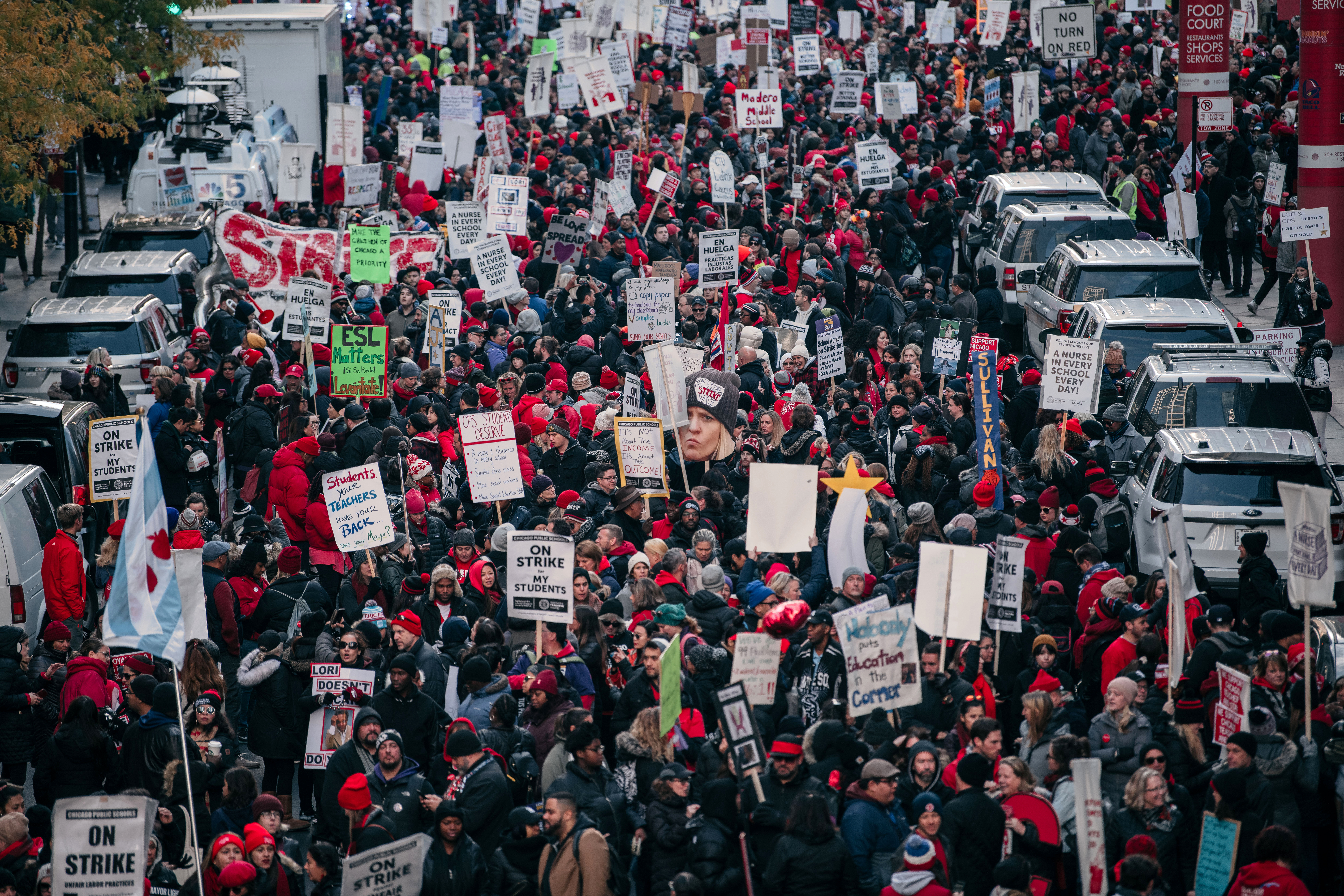Chicago Teachers Fought For Support Staff And Restorative Justice In Schools
After an 11-day strike, the Chicago Teachers Union won guarantees of nurses and social workers in every school and a “path” towards hiring librarians, counselors, and restorative justice coordinators.

Spotlights like this one provide original commentary and analysis on pressing criminal justice issues of the day. You can read them each day in our newsletter, The Daily Appeal.
On Friday, Chicago teachers and staff returned to school after an 11-day walkout, the longest teachers’ strike in three decades in the city. It had been seven years since the 2012 Chicago Teachers Union (CTU) strike that helped spark a wave of actions around the country, in West Virginia, Oklahoma, and Arizona—and more recently in Los Angeles and Oakland, California—and contributed to the formation of a network known as “Bargaining for the Common Good.”
Joseph McCartin, a labor historian at Georgetown University, told Rebecca Burns for In These Times that “in many ways this was both the toughest and most visionary strike fought yet” using the principles of bargaining for the common good.
The Chicago Teachers Union’s demands went beyond salary raises and improved benefits, although those were sought and won. The union, fundamentally, sought greater investment in and protections for students and staff, at school and in the community. These included sanctuary for undocumented students and staff on campus; more mental health staff, nurses, counselors, and librarians; reduced class sizes; and even affordable housing.
The strike ended after the teachers and staff won many, but not all, of their demands. As Burns wrote: “While the union didn’t win on housing assistance for new teachers or gain the school district’s support for rent control, one of CTU’s earliest and clearest victories was an agreement to hire staff specifically to support the more than 17,000 homeless students in Chicago Public Schools—an approach that could be a model for other school districts.”
The union also won a commitment to bilingual education and a guarantee that Chicago public schools will be sanctuary spaces for undocumented students and staff—significant victories in a school district where nearly half of all students are Latinx. Burns reports that “the school district will create a training program for staff on how to respond to ICE presence in schools and assist immigrant students” and will allocate up to $200,000 each year to assist employees with immigration issues.
The teachers union fought long and hard on the issue of increased support staff. As one teacher told the Washington Post, describing her students’ unmet needs: “Every day we go to work, the stress level is sky-high. The kids are not ready to learn, they suffer a great deal of trauma, they are hungry and tired. I can’t do every job.”
Under the agreement reached last week, the district will, over a five-year period, guarantee nurses and social workers in every school. With respect to other support staff, including librarians, counselors, and restorative justice coordinators, “the agreement creates a joint union-school district committee on ‘staffing equity’ that will provide a path—but not a guarantee—for high-need schools to hire” the staff, writes Burns.
The union’s inclusion of restorative justice coordinators in the support staff being sought is noteworthy. In Chicago, as around the country, students of color and students with disabilities have borne the brunt of harsh school disciplinary measures. The consequences for students’ involvement in the criminal legal system have been clear, particularly as school districts increasingly bring police officers onto campus.
Chicago’s policing problems, which eventually led to a federal consent decree this year, have not spared its schools. In January, two police officers dragged a 16-year old high school student, Dnigma Howard, down a flight of stairs, and then punched her in the face and used a stun gun on her. Until video footage contradicting their claims was released by media outlets, the officers insisted that the student, who did admit to biting one officer, had initiated the altercation. The teenager was initially charged in juvenile court with felony counts of aggravated battery. The charges were eventually dropped by the Cook County’s state’s attorney’s office “in the interest of justice.” The teenager is now suing the city and the school district for violations of her civil rights. She is also suing for the release of body camera footage from the officers involved.
The officers were summoned when Dnigma, who has special needs, was using her cell phone in class. A school security guard refused to allow her to see an administrator or a counselor, in violation of her Individualized Education Plan (contracts between students eligible for special education services and school districts).
The 2017 U.S. Department of Justice report that documented the Chicago police’s systematic abuse and violence against residents included an alarmingly similar incident, in which officers used a baton and a stun gun on a 16-year-old girl after being summoned over her use of a cell phone.
In 2016, in a review of 2013-14 civil rights data and research on educational inequities, a White House report detailed the way disparities in the use of harsh discipline measures in schools went hand-in-hand with a lack of funding for support staff and services for students. Combined, students of color “are between roughly 20 and 40 percent more likely to be one of the 1.6 million students who attend a school where there is a school law enforcement officer but no guidance counselor.”
And the two are linked, the report noted: “Research suggests that discipline problems could be compounded when resources are diverted from guidance counselors, whose presence helps to reduce disciplinary incidents and also to raise academic achievement.”
This year in Chicago, just months before teachers went on strike to fight for support staff for their students, the school board approved $33 million for school-based police officers.
